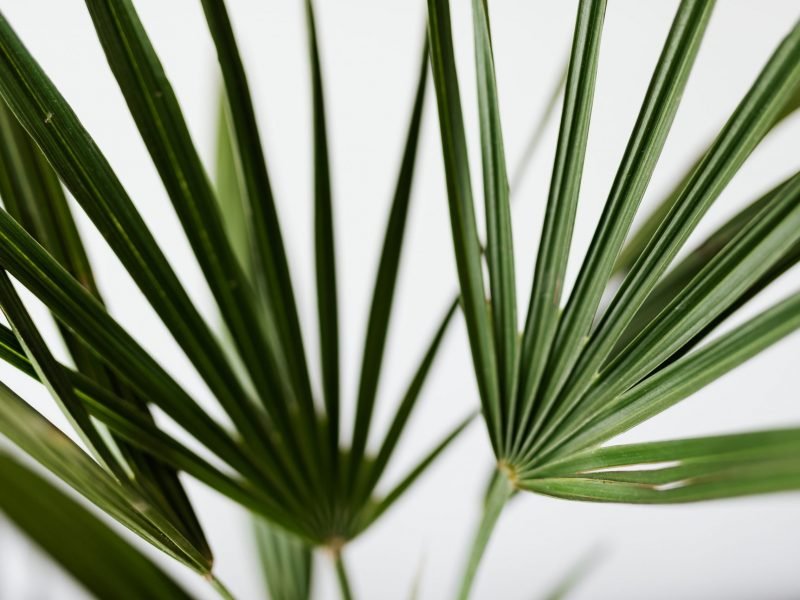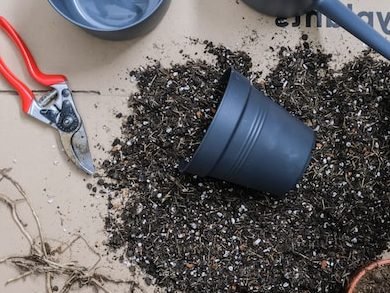
Although these Palms can be pretty hardy and adjust well to a range of environments, they aren’t totally immune to the common problems we often face as plant parents. If you have started to notice that your Fan Palm is dying, then it’s important to correctly diagnose the issue as soon as possible. Catching problems early is the key to saving your Fan Palm.
In this article, we will go through each of the main causes of a dying Fan Palm as well as methods to solve and prevent the problem in future.
Overwatering can kill a Fan Palm
If you notice that your Palm’s leaves are developing brown or yellow patches and are drooping down, then this is most likely caused by too much moisture in the soil. This is actually the most common problem that leads to dying houseplants or all kinds as it can very quickly damage the root system.
Too much moisture can lead to root rot which is very harmful to your plant. Not only does it cause the leaves to develop yellow and brown spots or patches (or in some cases the entire leaves can go yellow or brown), but it can also mean that the plant is unable to take up water or nutrients meaning your plant may begin to droop and die pretty quickly.
If you think that you may have overwatered your Fan Palm, check the moisture in the soil to confirm the issue. It’s also a good idea to check the root system to see if it has started to rot. Rotten roots will be soft to touch and black/dark brown in appearance.
To solve the issue, replace any waterlogged soil so that your plant can begin to recover. Waiting for the soil to dry naturally only risks more damage. You also should remove any rotten roots.
To prevent the issue in future, make sure to check the moisture in the soil before you water your Fan Palm. There are two really easy ways to make sure that it definitely needs water. First check the moisture at the top of the soil, if it is still damp then wait at least a week before watering. You can also use a moisture meter for a more accurate reading of the soil moisture and these will help you develop and adjust your watering routine.
Your watering schedule should change throughout the year depending on the growing seasons. Fan Palms really don’t need much water at all during autumn and winter, once a month should be plenty!
A dying Fan Palm can suggest underwatering
Like overwatering, too little water can also be harmful to your Fan Palm. It is a slower-to-progress problem in contrast to overwatering but can be equally as damaging if not solved. Consistent underwatering over a few months will really start to have an impact on your plant’s health, causing it to dry up, turn brown, droop down and lose some of its lower leaves.
To diagnose the issue, check the soil moisture immediately using the finger/chopstick method, the lifting method or a moisture meter for a more accurate reading.
If you find that your Fan Palm feels very dry, water it a little every other day for a week. Your first instinct might be to give it a watering can full of water straight away but this can actually be harmful to your plant if the soil goes from one extreme to the other (plants get shocked and stressed too!). Instead, you want to reintroduce frequent watering for a week or two and this should solve the problem.
In future, adjust your watering schedule so that you are either watering your Fan Palm more deeply than before or more frequently.
Too little sunlight can cause a dying Fan Palm
If your Fan Palm’s growth has recently become quite leggy or stagnant and your whole plant looks a bit lifeless than it might not be getting enough sunlight. This is commonly an issue during winter as the sun is weaker and out for less of the day.
If you suspect that a lack of natural sunlight is the cause, start by placing your Fan Palm nearer to a window to help revive it. If this happens during winter, you can get away with placing it right by the window as the direct sun rays won’t be as intense as in summer. However, if this is happening during the height of summer, you’ll want to be a little more cautious as intense light can cause a whole host of issues of its own.
If you aren’t able to find a sunnier spot for your dying Fan Palm, then you might opt to use an LED grow light to supplement light levels. They are great to help your plants through winter and can also be used when propagating seeds and cuttings. So a great investment all around!
Low humidity could be causing your Palm to die
Another reason why your Fan Palm is dying could be a lack of humidity as they can struggle in homes with dry air. Whilst this won’t cause a sudden problem from one day to the next, it can develop slowly over time. You’ll often spot dry brown leaf tips as the first sign of trouble but this can also develop into entire brown leaves and limp droopy stems.
Luckily, if you have caught the problem early then this is quite an easy fix and you should be able to revive your plant in only a few days. Here are a few ways you can increase the humidity:
Misting your Palm regularly
One of the simplest ways to increase the humidity around your Fan Palm is to mist it with a spray bottle. You want to get into the habit of doing this a few times per week.
Build a pebble tray for your Palm
Place your Fan Palm over a tray of pebbles with fresh water over the top. Over the day water from the tray will evaporate giving your plant exactly what it’s looking for. Just make sure that the water level in the tray doesn’t reach your plant as this can cause some issues related to root rot.
Move your Fan Palm to the bathroom
If you’re lucky enough to have great lighting in your bathroom you can move your Fan Palm in there to increase the humidity.
The running water from your showers means your bathroom is naturally one of the most humid in your home.
Another great room for high humidity is the kitchen due to the steam from cooking. Just be sure not to put your plant too close to the cooker or it may cause the leaves to burn and dry out.
Buy a humidifier
They’re relatively affordable little devices which keep a consistent humidity level in your home. This is the long-term and most reliable solution so are great if the issue has progressed quite far or you find yourself forgetting to mist enough.
Pests might be to blame
A slightly rarer issue that might be causing your Fan Palm to die is a pest infestation. Check over your plant to see if you can spot actual insects or signs of them (you want to be looking for brown or yellow spots, holes in the leaves or white webbing across the stem).
Whilst an infestation is more common in a plant that is struggling due to the wrong environment or one that has spent some of the year growing outdoors, it can happen to a houseplant in good health too so it’s an important one to rule out if your Fan Palm looks like its dying.
If you spot pests lurking on your plant (or signs that they might be there) the first thing to do is isolate your plant from all of your other houseplants to prevent the infestation from spreading. The next step is to trim off the worst affected leaves and replace the potting mix to curb the growth of the infestation. Then give your plant a wash down in the sink and treat it with an insecticide/neem oil.
A pest infestation isn’t always a death sentence to the infected plants, especially if you have caught the problem early. But if you are struggling to stop the infestation after treating it several times with an insecticide and neem oil, then it may be best to say goodbye to your plant. As much as this can be heartbreaking, it prevents the problem from spreading to your other beloved houseplants so is often better in the long run.
Those are the main causes of a dying Fan Palm. It’s important once you’ve diagnosed the issue and made changes to its environment and care routine, that you keep a very close eye on your plant. You want to make sure that you’ve not only figured out what is causing it, but also that things are getting better and not worse.
To learn more about how to keep your plant happy and healthy for years to come, check out our Fan Palm care guide.















